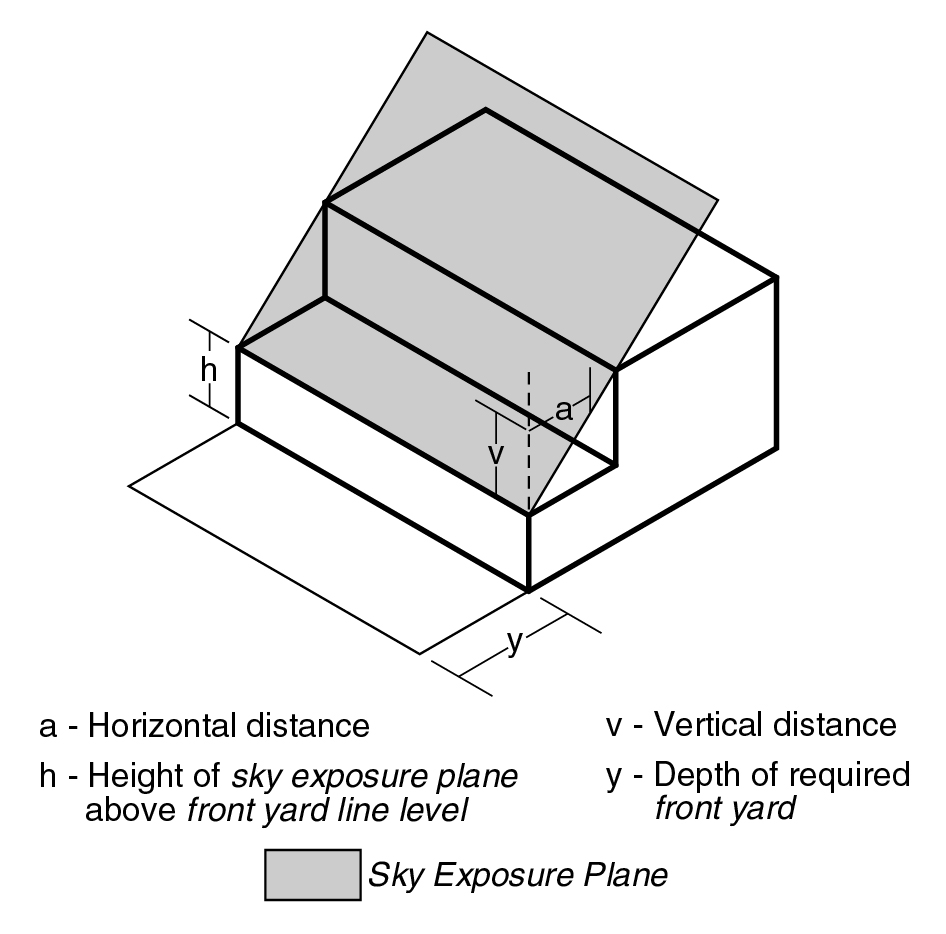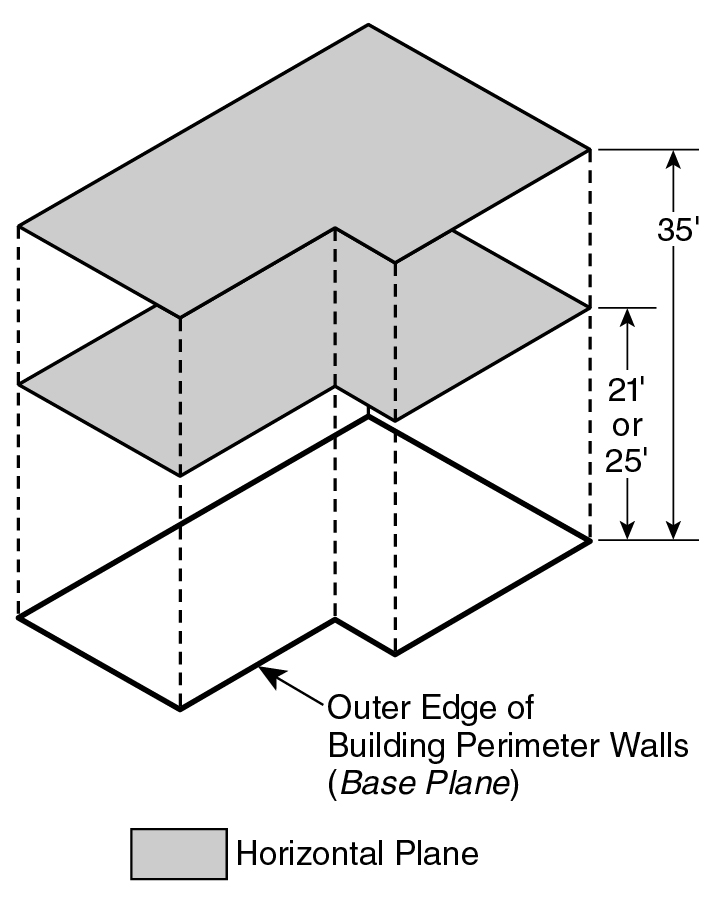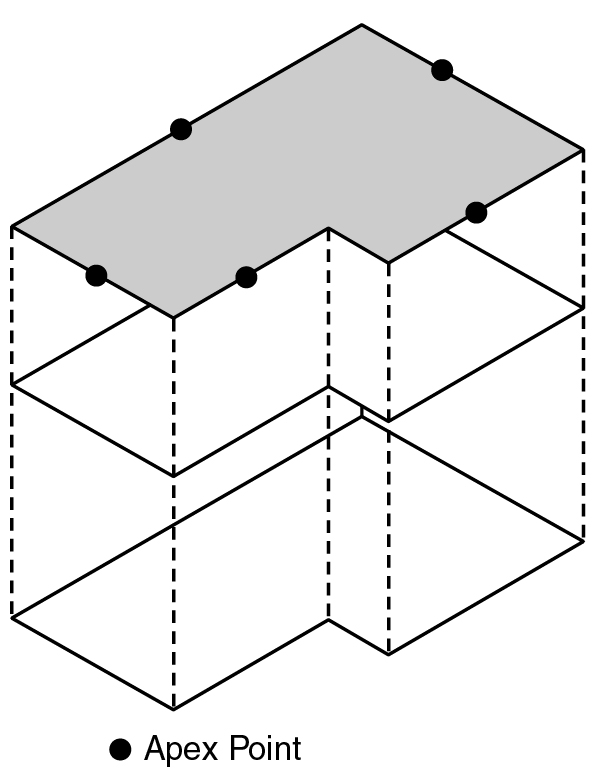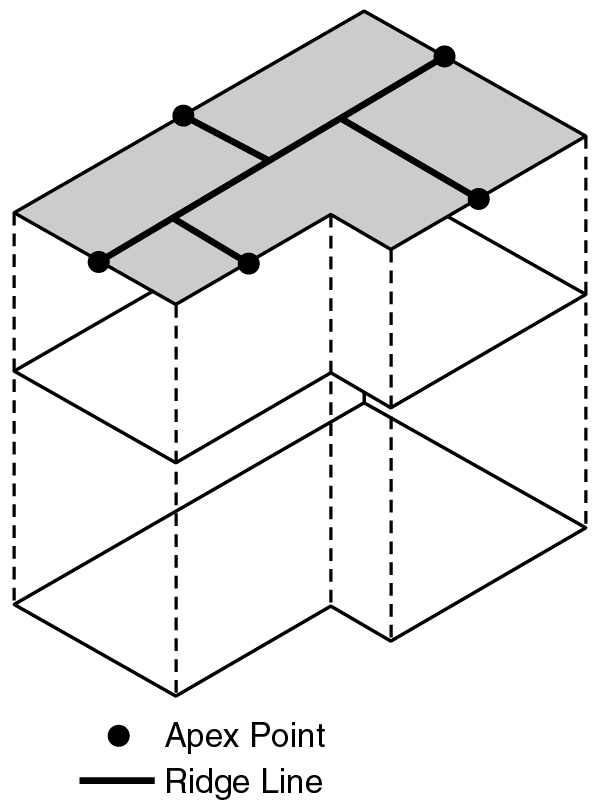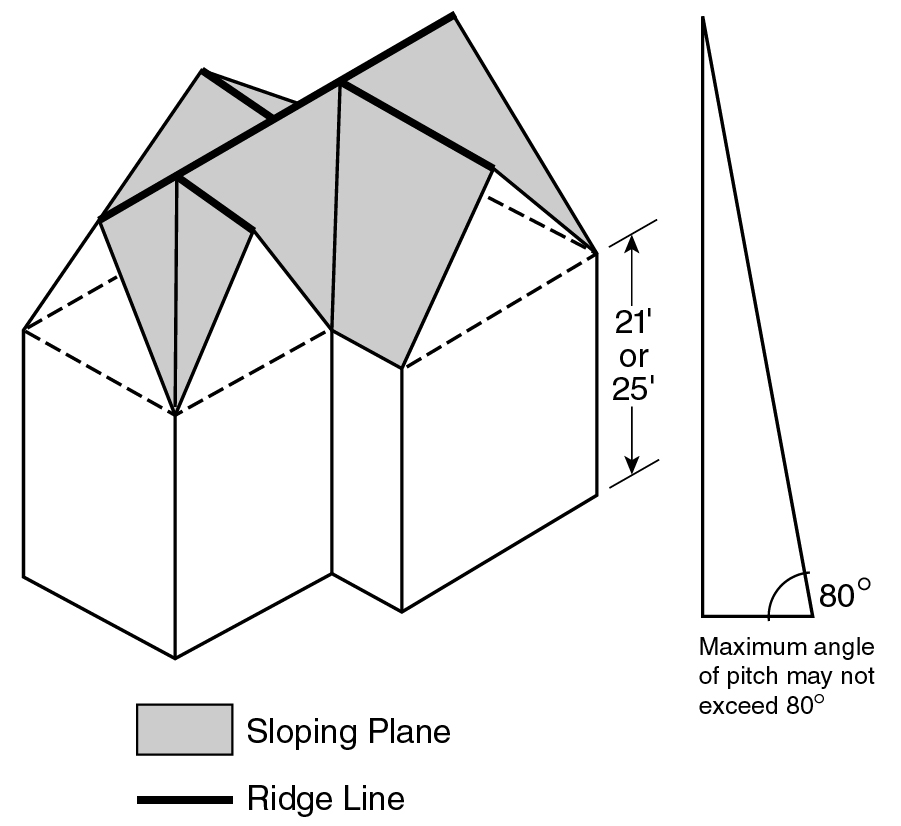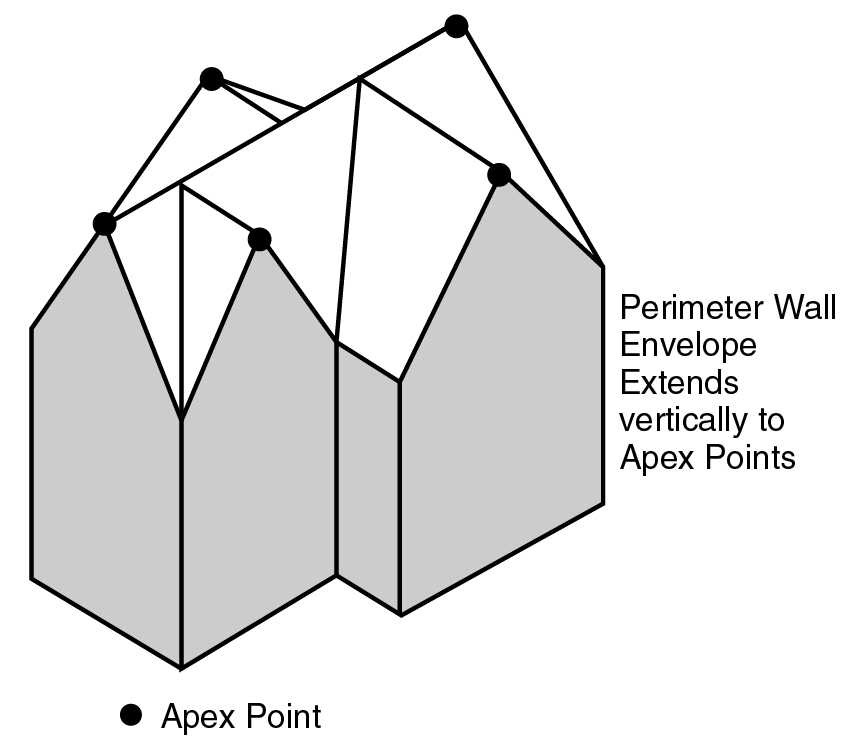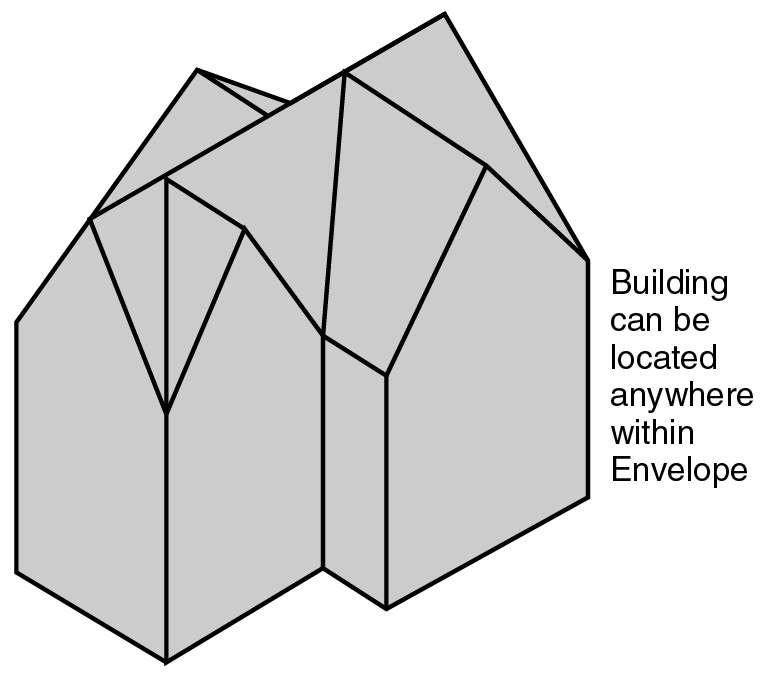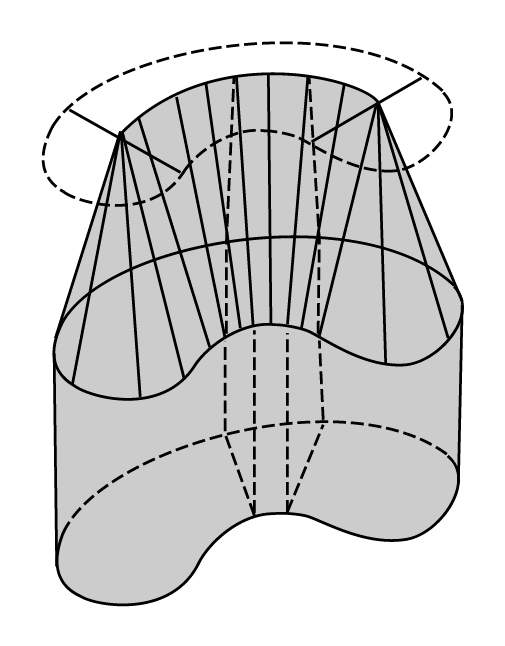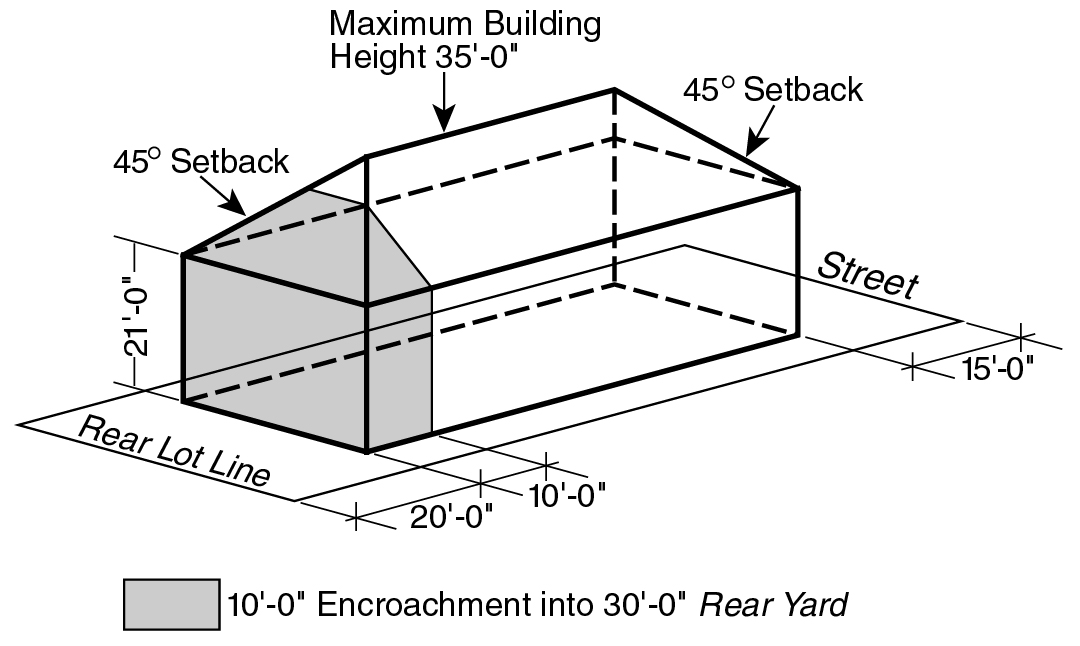General provisions
Height and setback regulations for R1 through R5 Districts are set forth in this Section. Such maximum heights may only be penetrated by permitted obstructions set forth in Section 23-62.
R1 R2
(a) In the districts indicated, except R1-2A, R2A and R2X Districts, the front wall or any other portion of a building or other structure shall not penetrate the sky exposure plane set forth in the following table:
MAXIMUM HEIGHT OF FRONT WALL AND REQUIRED FRONT SETBACKS
Height above Front Yard Line (in ft.) | Sky Exposure Plane | District | |
Slope over Zoning Lot (expressed as a ratio of vertical distance to horizontal distance) | |||
Vertical Distance | Horizontal Distance | ||
25 | 1 to | 1 | R1 R2 |
SKY EXPOSURE PLANE
(23-631a, 24–521)
R1-2A R2A R2X R3 R4 R4-1 R4A R5A
(b) In the districts indicated, the height and setback of a building or other structure shall be as set forth herein except where modified pursuant to paragraphs (h) and (j) of this Section.
For the purposes of this Section, where base planes of different elevations apply to different portions of a building or other structure, each such portion of the building may be considered to be a separate building. Furthermore, for the purposes of this Section, building segments may be considered to be separate buildings and abutting semi-detached buildings may be considered to be one building.
The perimeter walls of a building or other structure are those portions of the outermost walls enclosing the floor area within a building or other structure at any level and height is measured from the base plane. Perimeter walls are subject to setback regulations at a maximum height above the base plane of:
21 feet | R2A R2X R3 R4A |
25 feet | R1-2A R4-1 R4 R5A |
26 feet | R3 R4-1 R4A within lower density growth management areas |
Above these heights, sloping planes control the maximum height of the building or other structure requiring either a setback or a pitched roof. These planes start at the maximum permitted height of the perimeter walls and meet at a ridge line of 35 feet above the base plane. The exact locations of these planes are flexible and are determined in the steps set forth in paragraphs (b)(1) through (b)(5), as follows:
(1) At a height of 35 feet above and parallel to the base plane, a plane is projected above the area enclosed by and including the perimeter walls of the building or other structure. A second plane (the perimeter wall plane) is projected in the same manner at a height of 21 or 25 feet above the base plane. (See Figure A)
Figure A
(23-631b1)
(2) Each perimeter wall of the building or other structure with a horizontal dimension of eight feet or more which projects from an adjacent perimeter wall at least 18 inches may have an apex point directly above it on the 35 foot high plane. (See Figure B). The location of the apex point is flexible provided it is directly above its perimeter wall and provided a line drawn from the intersection of two perimeter walls to such an apex point does not exceed 80 degrees to the horizontal. An apex point is not required for each qualifying perimeter wall; however, the maximum number of apex points above each such wall is one.
Figure B
(23-631b2)
(3) One "ridge line" is extended in a straight line from each apex point along the 35 foot high plane. Ridge lines which connect two apex points may cross other ridge lines. Otherwise, ridge lines which extend from only one apex point must terminate at a point of intersection with another ridge line. (See Figure C)
Figure C
(23-631b3)
(4) Sloping planes are extended in a straight line outward and downward from each ridge line until they intersect the perimeter wall plane. Every sloping plane generated must intersect the perimeter wall plane for the full width of the ridge line from which it extends. (See Figure D). The maximum angle of pitch for any sloping plane may not exceed 80 degrees to the horizontal. Sloping planes extended from ridge lines perpendicular or within 45 degrees of being perpendicular to each other may intersect, in which case the higher plane defines the limit of the envelope. Sloping planes extended from ridge lines parallel or within 45 degrees of being parallel to each other must intersect the perimeter wall plane without intersecting each other.
Figure D
(23-631b4)
(5) The perimeter walls are then extended vertically beyond the perimeter wall plane, up to the heights defined by the sloping planes generated in paragraph (4). (See Figure E). The perimeter walls of the building or other structure, the sloping planes and the perimeter wall extensions define the building envelope. (See Figure F). Those items listed in Section 23-44 (Permitted Obstructions in Required Yards or Rear Yard Equivalents), and roofed porches and porticoes subject to all applicable provisions, may penetrate the building envelope below the maximum permitted perimeter wall height. Eaves may extend the roof lines 18 inches beyond the exterior walls.
(23-631b5.1)
Figure E and F
(23-631b5.2)
(6) Special Situations
(i) For convex curved perimeter walls, the building or other structure must be within a plane curve tapering uniformly to a vertex located at a height of 35 feet. For concave curved perimeter walls, the building or other structure must lie within a plane curve extending from the maximum perimeter wall height to a ridge line parallel to the prolongation of the perimeter wall at the 35 foot level. Such plane curves may not exceed a pitch of 80 degrees in relation to a plane drawn parallel to the base plane at the maximum height of the permitted perimeter wall. (See Figure G).
Figure G
(23-631b6.i)
(ii) In R2X Districts, at the 21 foot maximum permitted height of a perimeter wall, sloping planes are projected inwards and upwards. From a permitted front perimeter wall and from 21 feet above the base plane and 20 feet from and parallel to a rear lot line, such sloping plane shall not exceed a pitch of 45 degrees in relation to a plane drawn parallel to the base plane at a height of 21 feet. (See Figure H). Other sloping planes slope toward a ridge line at 35 feet and may not exceed a pitch of 80 degrees in relation to a plane drawn parallel to the base plane at a height of 21 feet.
Figure H
(23-631b6.ii)
R4B
(c) In the district indicated, no portion of the building or other structure, including the apex of a roof, shall penetrate a plane 24 feet in height above the base plane.
R5
(d) In the district indicated, except R5A, R5B and R5D Districts, no portion of a building or other structure, including the apex of a roof, may penetrate a plane 40 feet above the base plane. In addition, the maximum height of a street wall above the base plane shall be 30 feet. Above such height, a setback of 15 feet is required. Within the setback distance, no portion of the building or other structure, including the apex of a roof, may penetrate a plane rising from the maximum street wall height, at 20 degrees to the horizontal. On corner lots, the 30 foot maximum street wall height shall apply to only one street frontage. Buildings or other structures which utilize the optional regulations of Section 23-143 applying to a predominantly built-up area shall be subject to the height and setback regulations for an R5B District. The provisions of this paragraph may be modified pursuant to paragraphs (h) and (j) of this Section.
R5B
(e) In the district indicated, no portion of a building or other structure, including the apex of a roof, may penetrate a plane 33 feet above the base plane. In addition, the maximum height of a street wall above the base plane shall be 30 feet. Above such height, no portion of the building or other structure shall penetrate a plane rising from the maximum street wall height, at 20 degrees to the horizontal, to a maximum height of 33 feet above the base plane. On corner lots, the 30 foot maximum street wall height shall apply to only one street frontage. The provisions of this paragraph may be modified pursuant to paragraph (h) of this Section.
R5D
(f) In the district indicated, no portion of a building or other structure shall penetrate a plane 40 feet above the base plane. However, where the ground floor level of a building provides a qualifying ground floor in accordance with the supplemental provisions set forth in paragraph (b)(2) of Section 23-662, the maximum height of a building or other structure may be increased to 45 feet, or four stories, whichever is less.
R3A R4-1 R4A R4B R5B
(g) In the districts indicated, a second story line-up is required as follows:
Where at least 75 percent of the buildings containing residences within 150 feet of the side lot lines of the zoning lot have a first story front projection that is at least 50 percent of the width of the building, the street wall shall be no closer to the street line than the second story street wall of an adjacent building containing residences facing on the same street.
Projections from the first story street wall are permitted provided that such projections are no closer to the street line than an adjacent front yard line, and such projections are no higher than 13 feet above the street wall line level. Projections from the second story street wall are permitted provided that the width of all projections at that level does not exceed 33 percent of the width of the building at the second story, and the depth of the projections does not exceed three feet.
(h) The height and setback regulations of this Section are modified as follows:
(1) In R3-1 and R3-2 Districts, single- or two-family detached residences on zoning lots of at least 9,500 square feet in area and at least 100 feet of frontage along a street may use the height and setback regulations applicable in an R2 District.
(2) In the Special Ocean Parkway District, the Special Coney Island Mixed Use District, and the Special Hunters Point Mixed Use District, for buildings or other structures subject to the regulations of an R5 District other than an R5D District, no portion of a building or other structure, including the apex of a roof, may penetrate a plane 40 feet above the base plane. In addition, the maximum height of a street wall above the base plane shall be 32 feet. Above such height, a setback of 15 feet is required. Within the setback distance, no portion of the building or other structure, including the apex of a roof, may penetrate a plane rising from the maximum street wall height at 20 degrees to the horizontal. On corner lots, the 32 foot maximum street wall height shall apply to only one street frontage.
In these special districts, for developments or enlargements which utilize the optional regulations applicable to a predominantly built-up area, the maximum height of a building containing residences shall not exceed 32 feet above the base plane. Furthermore, for such developments or enlargements with pitched roofs, the midpoint of such pitched roof shall not exceed a height of 32 feet above the base plane. The provisions of this paragraph may be modified pursuant to paragraph (j) of this Section.
(3) In accordance with Section 78-31 (Location of Buildings, Distribution of Bulk and Open Space and Modification of Height and Setbacks), buildings within a large-scale residential development may use the alternate height and setback regulations set forth in paragraphs (b)(1) through (b)(3) of Section 78-31.
R3-2 R4 R5
(i) In R3-2 Districts, buildings containing affordable independent residences for seniors may use the height and setback regulations applicable to an R4 District, as set forth in paragraph (b) of this Section.
(j) In R4 and R5 Districts, except R4-1, R4A, R4B, R5A, R5B and R5D Districts, the height and setback provisions set forth in paragraphs (b) and (d) of this Section shall apply to buildings containing affordable independent residences for seniors. However, where no single-family or two-family residence existed on the zoning lot within three years prior to the issuance of a building permit for the development or enlargement of such building containing affordable independent residences for seniors, such height and setback provisions shall be modified as follows:
(1) in R4 Districts, the height of the building shall not exceed 45 feet; and
(2) in R5 Districts, the height of the building shall not exceed 45 feet, except that beyond 25 feet of a street line, the height of the building may be increased to a height of 55 feet where one or more of the following conditions are met:
(i) on the date of application for a building permit for such development or enlargement, not more than 50 percent of the aggregate length of the block frontage on both sides of the street facing each other is occupied by single-family or two-family residences;
(ii) an existing building on the same or adjacent zoning lot of such development or enlargement has a height of 45 feet or more; or
(iii) the zoning lot of such development or enlargement has a lot area of at least 1.5 acres.
(k) In the districts indicated, except R4-1, R4A, R4B, R5A, R5B and R5D Districts, the City Planning Commission may authorize a building or other structure that penetrates the height and setback regulations set forth in paragraphs (b), (d) or (i) of this Section, except for buildings utilizing the optional regulations for predominantly built-up areas. As a condition for granting such authorizations, the Commission shall find that:
(1) by concentrating permitted floor area in a building or buildings of greater height, the preservation of an existing building, topography, vegetation, or view corridors having environmental, historic or aesthetic value to the public will be assured, and that such preservation would not be possible by careful siting of lower buildings containing the same permitted floor area; or, for affordable independent residences for seniors, the additional floor area permitted is accommodated in an efficient manner;
(2) such modification is the least modification required to achieve the purpose for which it is granted;
(3) the proposed modification does not impair the essential character of the surrounding area; and
(4) the proposed modification will not have adverse effects upon light, air, and privacy of adjacent properties and of any existing buildings on the zoning lot.
Applications for authorizations shall be referred to the affected Community Board for a period of at least 30 days for comment. The Commission shall grant in whole or in part or deny the application within 60 days of the completion of the Community Board review period.

